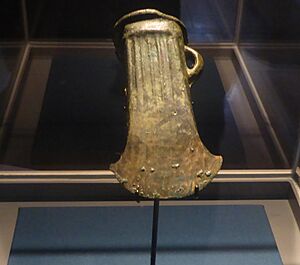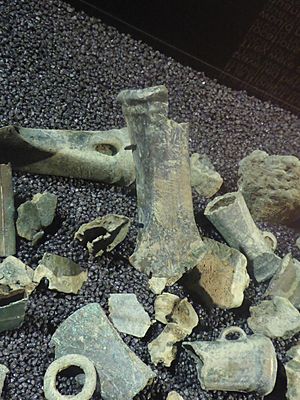Havering hoard facts for kids
The Havering hoard is a huge collection of 453 ancient objects from the late Bronze Age. These items are about 2,800 to 2,900 years old! They were found in 2018 near the River Thames in Rainham, London.
This discovery was very important because it's the biggest Bronze Age hoard ever found in London. It's also the third largest in the entire United Kingdom. The hoard includes weapons, tools, and metal pieces called ingots. What's special is that it was buried in four different spots, not just one. Some items even came from other parts of Europe, showing that people traded a lot back then.
Today, you can see these amazing objects at the Museum of London Docklands. Later, they will move to the Havering Museum in Romford.
Finding the Hoard
The Havering hoard was found in 2018. This happened during an archaeological dig in Rainham, in the London Borough of Havering. The land was going to be used for digging up gravel.
Archaeologists had thought this area might be important since the 1960s. Pictures taken from the air showed old earthworks, which are signs of ancient human activity. The area around Rainham is already known for having many Bronze Age finds.
The Big Discovery
The hoard was found on a Friday afternoon by Harry Platts, a 21-year-old archaeologist. He had only been working for the company for about a month! Harry first found an axe head. His team then worked extra hours to find more objects buried together in a pit.
The discovery was officially called "treasure" by the authorities. This means it's very important and belongs to the public. Harry Platts later went on to study archaeology even more at the University of York.
What Was Found?
The Havering hoard was found in four different places within a large ancient ditch. Experts believe the 453 objects were carefully placed there on purpose. The whole collection weighed about 45 kilograms (100 pounds)!
The hoard included many different items:
- Swords
- Axe heads
- Spear heads
- Knives
- Daggers
- Tools for working with wood
- Tools for working with metal
- Ingots (metal blocks)
There were also two special rings called terret rings. These were used on Bronze Age carts to stop the reins from getting tangled. These rings had only been found in France before! There wasn't much jewellery, but one bracelet came from north-western France. Some axes and copper ingots might have come from the Alps mountains. These finds show that people in this area had strong connections and traded with people across Europe during the Bronze Age.
Why Was It Buried?
Most of the weapons found in the hoard were broken or damaged. It's also unusual to find so many separate collections of items in one hoard. Usually, hoards are all in one spot.
Scientists have many ideas about why the Havering hoard was buried:
- Some think it was a religious offering to gods.
- Others believe it was a place where a metal worker collected old bronze to melt down and reuse.
- It might have been a hidden stash belonging to a travelling metal worker who didn't want to carry heavy goods.
- Another idea is that people stopped using bronze tools when iron tools became popular at the start of the Iron Age. So, they just left their old bronze items.
- It could also be that a powerful person was trying to control the trade of bronze in the area.
No one knows for sure why the hoard was never dug up again in the Bronze Age.
Where to See It
The Havering hoard was first planned to be shown in April 2020 at the Museum of London Docklands. However, the COVID-19 pandemic caused the museum to close. It finally opened in August 2020. After the exhibition ends there, the amazing finds will be displayed at the local Havering Museum.



